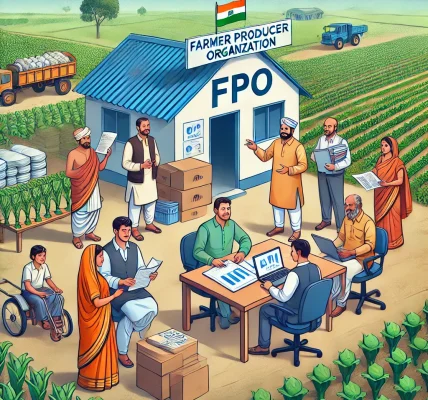Export Promotion Schemes for Indian Farmers: Expanding Global Reach – A DIY Guide
Introduction
Agricultural exports play a crucial role in India’s economy, providing farmers with opportunities to expand their businesses and earn higher profits. The government of India has introduced various export promotion schemes to support farmers, agribusinesses, and agricultural cooperatives in reaching international markets. However, many farmers struggle with the application process and often rely on agents who charge high fees.
This guide provides a step-by-step approach to applying for export promotion schemes without an agent, ensuring that farmers can directly access financial aid and government benefits.
1. Importance of Export Promotion for Indian Farmers
Government-backed export schemes aim to:
- Increase the global market reach of Indian agricultural products.
- Provide financial support for quality certification, packaging, and logistics.
- Encourage organic and value-added product exports.
- Ensure compliance with international food safety standards.
- Enhance India’s agricultural trade competitiveness.
These schemes benefit small and marginal farmers, FPOs (Farmer Producer Organizations), agricultural startups, and exporters by providing subsidies, market linkages, and financial incentives.
2. Key Government Export Promotion Schemes
a) Agricultural and Processed Food Products Export Development Authority (APEDA) Schemes
- Provides financial assistance for infrastructure, market development, and quality certification.
- Supports export-oriented projects in organic farming, horticulture, and dairy.
- Reimbursement for ISO certification, branding, and packaging improvement.
b) Market Access Initiative (MAI) Scheme
- Financial assistance for participation in international trade fairs and buyer-seller meets.
- Support for product promotion campaigns and overseas market research.
- Subsidies for branding, advertising, and foreign retail tie-ups.
c) Merchandise Exports from India Scheme (MEIS)
- Provides incentives on the export of notified agricultural products.
- Encourages value-added exports by offering duty credit scrips.
- Helps exporters to offset high transaction and logistics costs.
d) Remission of Duties and Taxes on Exported Products (RoDTEP)
- Refund of embedded taxes and duties paid on exported agricultural goods.
- Ensures cost competitiveness in the international market.
- Simplified online claim process through DGFT (Directorate General of Foreign Trade).
e) Export Credit Guarantee Corporation (ECGC) Schemes
- Provides insurance and credit risk coverage for agricultural exporters.
- Protects farmers and traders from payment defaults by foreign buyers.
- Enhances bank loan eligibility for agri-export businesses.
f) National Horticulture Board (NHB) Export Assistance
- Subsidies for cold storage, quality control, and post-harvest management.
- Financial aid for global GAP certification and organic produce exports.
- Support for customized packaging and export-oriented agribusiness units.
3. Step-by-Step Guide to Applying Without an Agent
Step 1: Identify the Right Scheme
- Assess your export business requirements (e.g., logistics, branding, subsidies, certification).
- Choose the scheme that aligns with your agricultural product category and market needs.
- Check eligibility criteria on official government portals.
Step 2: Gather Required Documents
- Aadhar Card & PAN Card (for individual farmers).
- GST Registration Certificate (for commercial exporters).
- Import-Export Code (IEC) Certificate (mandatory for exports).
- FSSAI License & Organic Certification (if applicable).
- Bank account details & canceled cheque.
- Product testing & quality certification documents.
Step 3: Register on the Relevant Government Portals
- Visit https://apeda.gov.in for APEDA schemes.
- Apply on https://dgft.gov.in for MEIS and RoDTEP benefits.
- Register on https://ecgc.in for export credit insurance.
- Submit online applications, upload documents, and track status.
Step 4: Offline Application Process (If Needed)
- Visit the nearest Agricultural Export Facilitation Center, APEDA office, or NABARD office.
- Collect and fill out the required application forms.
- Submit hard copies of necessary documents.
- Obtain acknowledgment receipts for tracking purposes.
4. Advantages of Applying Without an Agent
- Avoid unnecessary commissions and middleman fees.
- Direct interaction with government authorities ensures transparency.
- Faster processing and approval when applications are filed through official channels.
- Higher chances of getting subsidies and incentives without fraudulent claims.
5. Avoiding Scams and Ensuring Legal Compliance
- Always apply through verified government websites.
- Do not share your personal or financial details with unauthorized agents.
- Be cautious of agencies promising guaranteed approvals for upfront payments.
- Maintain copies of all submitted forms and receipts.
- Check the authenticity of certifications and approvals before making investments.
6. Conclusion
India’s export promotion schemes provide farmers with valuable opportunities to enter global markets and improve their profitability. By following this DIY guide, farmers and agricultural entrepreneurs can apply for government incentives without relying on agents, ensuring a transparent and cost-effective application process.
Whether you are a small farmer, an FPO, or an agribusiness owner, these schemes can help you expand your agricultural exports, enhance product quality, and boost income. Apply today and take your farming business to the global stage! 🌾🌍🚢




